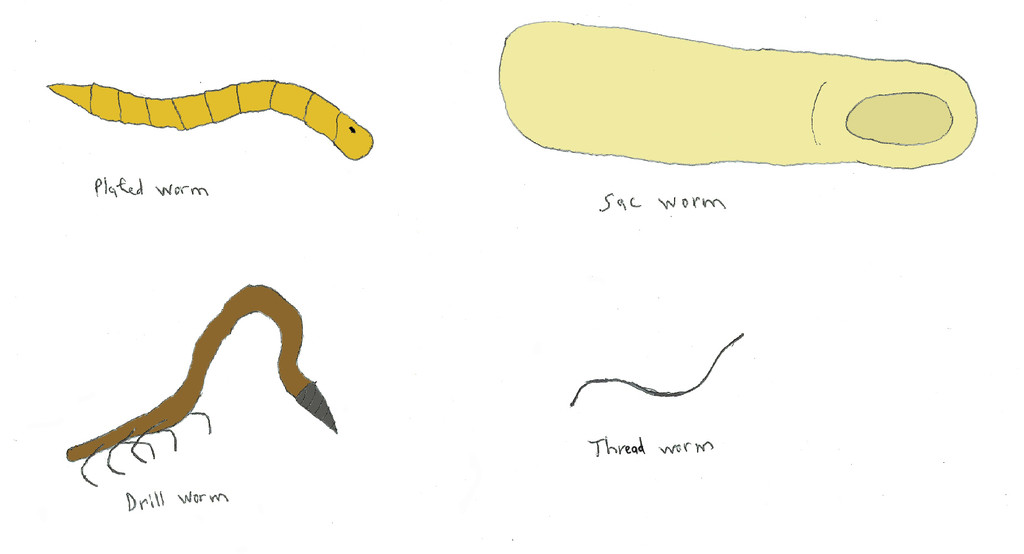HOME | DD
 Tarturus — Cerulean worms
Tarturus — Cerulean worms

#cerulea #plated #sac #soil #thread #tarturus #aliencreature #alienplanet #alienworld #burrower #predator #sciencefiction #scifi #smallanimals #worm #worms #xenobiology #speculativeevolution #speculativebiology
Published: 2018-11-15 04:55:46 +0000 UTC; Views: 996; Favourites: 7; Downloads: 1
Redirect to original
Description
While the Cerulean creatures people tend to notice the most are vertebrates, pseudo-arthropods, shield heads and radials, there are many more animal groups on the world beside these. Examples include such creatures as jelly masses, spore creatures, amoeboids, and various different types of worms.It seems that "worms" are something that can be found on practically any world with macroscopic multicellular life. A creature that is essentially a long tube is something so basic to evolve that it independently evolved time and again on world after world. Here are just a few examples of Cerulean groups that could be considered worms.
PLATED WORMS
This group is related to the pseudo-arthropods. Like them they are covered in a series of chitinous plates. Unlike the pseudo-arthropods though, plated worms have no limbs and no internal skeletons (though some do have small amounts of cartilage inside them). And unlike the pseudo-arthropods, plated worms have no megafaunal representatives. The largest of all the plated worms are only about half a metre in length and most are much smaller than this.
Plated worms are burrowing creatures living in the soil. Some feed on the roots of plants and polyp sacs, others hunt small burrowing creatures such as spade arms and smaller plated worms. Plated worms themselves are prey to creatures such as plate backs.
SAC WORMS
Molecular and phylogenetic studies have shown that sac worms are a sister phylum to the shield heads. This is not at all obvious by merely looking at them though. While shield heads are complex creatures with complex organ systems, shell plate skeletons and the chitinous head shields that give them their name, sac worms are essentially big soft sacs with no hard parts whatsoever and only the bare basics when it comes to organs. They have, for example, no brain, and their nervous, circulatory, and digestive systems are about as simple as can be. It is thought that the last common ancestor of the sac worms and the shield heads was likely some sort of simple soft-bodied sea worm. While the shield heads went on to evolve hard parts and complex organs, the sac worms kept a very simple design.
Sac worms are predatory. They lurk hidden in grass or other vegetation and will attack small creatures, such as small pseudo-arthropods. They have remarkably quick reaction and response times and will basically engulf their prey completely. While sac worms are completely harmless to humans, they have given many a curious human quite a startle when upon trying to pick up or just touch a sac worm they suddenly found their fingers enveloped by its mouth.
Usually, sac worms will not grow any larger than about 10 cm. However, the largest known species is a giant sac worm from Obsidian Island that grows up to 60 cm in length- a great example of island gigantism.
DRILL WORMS
These grotesque creatures are parasites, normally found in forests, but occasionally on the edges of the plains, and only in the southernmost regions of Occidentalis and Orientalis, and on a number of the southern islands. They latch onto larger creatures using six hook-like "legs". They then press a drill shaped structure on their head onto the creature's flesh. Twisting the front of their bodies round and round, they drill through the flesh and start eating once their head is lodged in the tasty meat.
Drill worms are not closely related to any of Cerulea's megafaunal groups. Technically speaking, they are closer to shield heads than to pseudo-arthropods and vertebrates, and closer any of these than to radials, but this is all relative.
THREAD WORMS
Thread worms are some of the most primitive of all of Cerulea's bilaterally symmetrical creatures. They are also a group that most people on Cerulea tend to not even give any notice whatsoever. Despite this they are actually some of the most common animals on the planet. Their reason for always being overlooked is their tiny size, ranging from microscopic to only just big enough to see with the naked eye. Thread worms also have a bit of a reputation for being somewhat "boring" creatures. They have an extremely simplistic form, being basically like a featureless thread. It is almost as if evolution was having a lazy day when it came up with thread worms.
That said though, thread worms are ecologically quite important, playing a major role in aerating soil and decomposing organic matter. Thread worms feed on detritus or on microbes. They themselves are prey to polyp sacs, who snatch up thread worms with tiny tendrils on their roots.

























